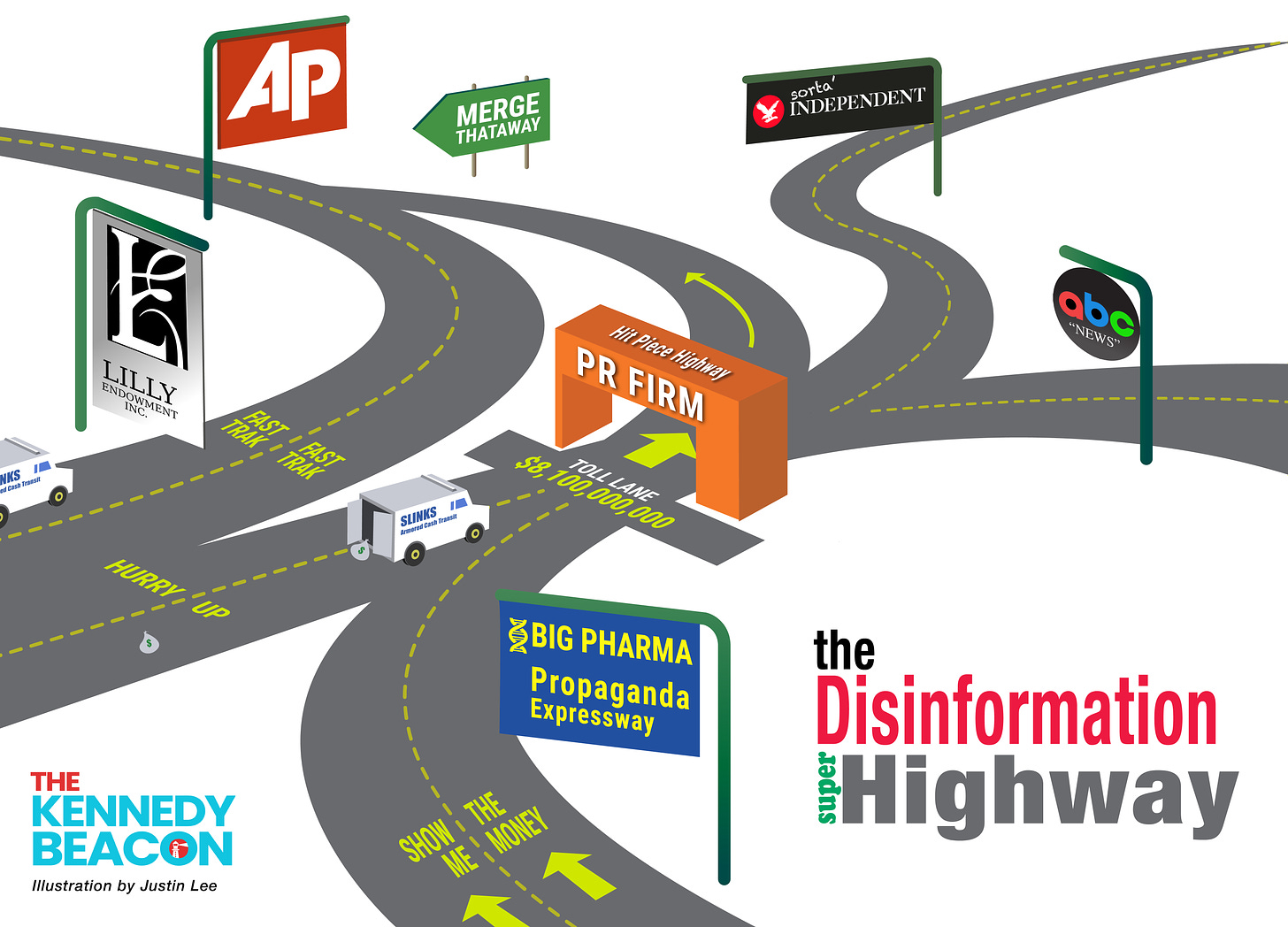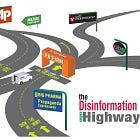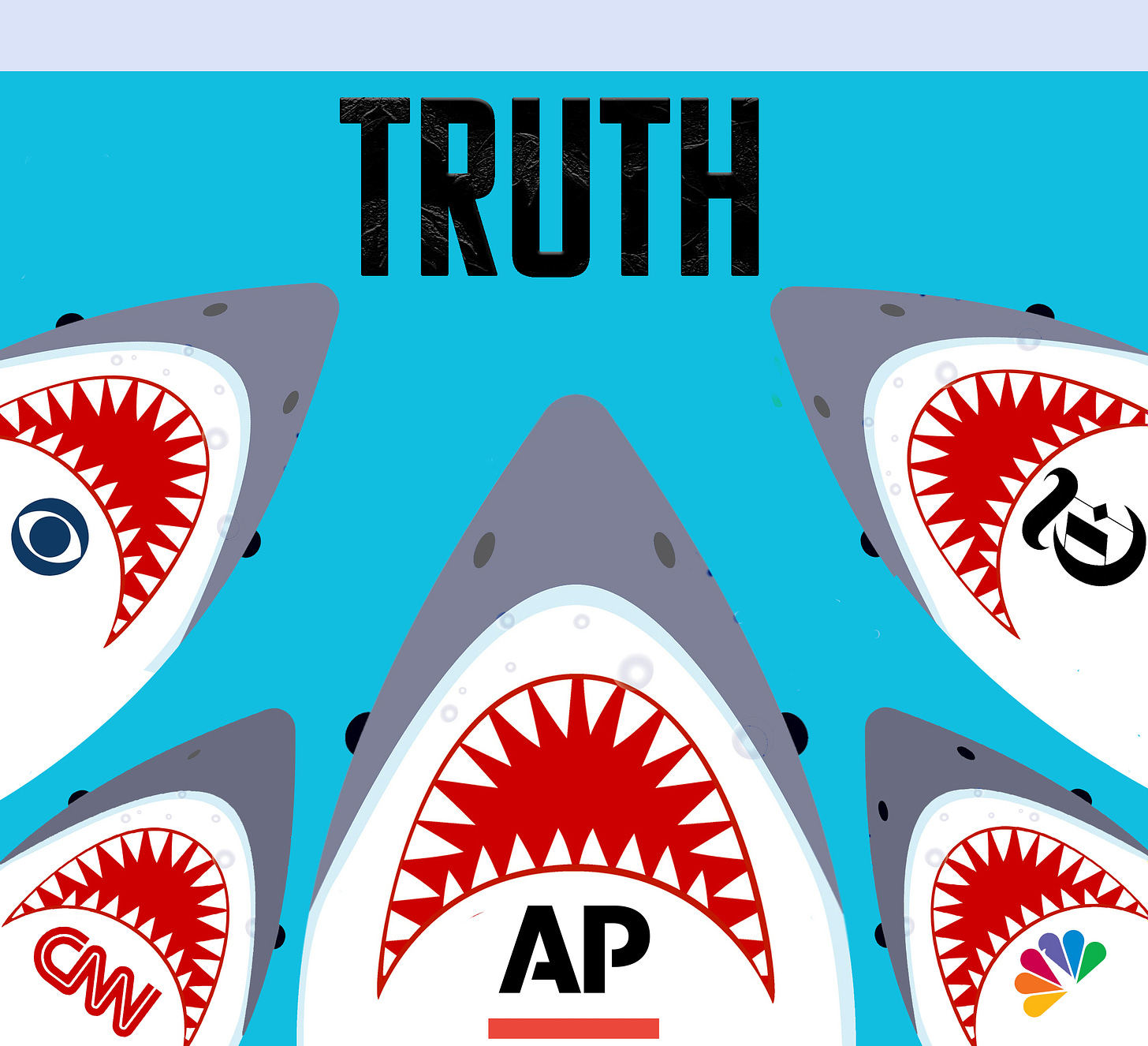Note: This is the third in a series of articles The Kennedy Beacon published on three consecutive days. Together, they examine how, nine days after Robert F. Kennedy Jr. announced his intention to run for president as an independent, the once-reputable Associated Press (AP) constructed a hit piece against the candidate that has all the hallmarks of Big Pharma dictating the method and line of attack. Our first article examined the claims of the hit piece; the second investigated Big Pharma’s fingerprints on the original story; and the third, below, reveals the financial/political conflicts of the authors, the AP’s leadership, and the organization as a whole.
By Liam Sturgess, The Kennedy Beacon
Over the course of several articles, The Kennedy Beacon has shone a spotlight on the Associated Press (AP) following its October 18 hit piece on independent presidential candidate Robert F. Kennedy Jr. titled “RFK Jr. spent years stoking fear and mistrust of vaccines. These people were hurt by his work.”
By now, readers will be familiar with the questionable journalistic practices underlying the piece and well versed in the financial stranglehold the pharmaceutical industry has on the mainstream media as a whole. The AP has demonstrated that it is no exception to this rule, despite its ostensible role as an independent, nonprofit news organization.
But organizations are not corrupted solely on the basis of their corporate structure. Behind every action are people with their own interests, coming together in a team to move their agenda forward, for better or worse. To complete our deep dive into the AP, we must get to know the people behind the curtain.
Let’s start with the article’s authors. Michelle R. Smith has worked for the AP for 23 years, according to her LinkedIn profile, starting as a TV editor and working her way up to her current job as an investigative correspondent. Much of her recent work has been focused on RFK Jr., former national security advisor Michael Flynn, terrorism, and, most prolifically, COVID-19. She participated in the production of Underfunded and Under Threat, a joint investigative series of the AP and Kaiser Health News which covered the national pandemic response. Rather than highlight a full range of perspectives, the series entrenched itself in its defense of institutional positions, reinforcing fundamental falsehoods about the nature of the public health threat and the supposed benefits of pandemic policies such as lockdowns and vaccine mandates.

Smith’s coverage of the COVID-19 pandemic received multiple awards, including the 2021 University of Florida Award for Investigative Data Journalism, Large Newsroom, copresented by the Online News Association. The ONA is a nonprofit organization whose funders include COVID-19 vaccine developer Janssen, the Google News Initiative, YouTube, Twitter, Facebook, the Council on Foreign Relations, and Participant Media, the production company behind the 2011 pandemic film Contagion. The film, with a plot based on a bat-borne virus eerily similar to the ostensible origin of SARS-CoV-2, helped establish a mental framework for the millions of Americans seeking to understand the nature of pandemics back in early 2020. As reported by CNBC in April 2020, the film’s creators “seemed to see a pandemic coming, and how various countries would react to it.” In his November 2020 article titled “Readapting Pandemic Premediation and Propaganda: Soderbergh’s Contagion amid COVID-19,” published in the journal Arts, researcher Kevin Moore explained that the film was “designed as a public health propaganda film to make people fear and better prepare for pandemics,” with a well-documented “influence agenda.” The ONA also discloses funding from Radio Free Europe/Radio Liberty, a US government-run agency described in the journal Law and Contemporary Problems as a propaganda outlet. Even more notable is the ONA’s financial partnerships with the world’s largest news outlets, such as Agence France-Presse, Bloomberg, CNN, Microsoft, NBC News, The New York Times, Reuters, the Los Angeles Times, The Wall Street Journal – and Smith’s employer, the Associated Press. One would be forgiven for suspecting a conflict of interest, if the AP helps fund the agency presenting it with an award.
Ali Swenson, Smith’s coauthor, “reports on election-related misinformation, disinformation and extremism” as a national political reporter with AP News, as listed in her profile. She previously covered the recent double break-in at RFK Jr.’s home and his announcement of his independent presidential run. She also wrote a hit piece on video hosting platform Rumble, which she described as “a haven for disinformation and extremism.” Smith’s LinkedIn profile reveals that she was trained at the Poynter Institute, a Florida-based nonprofit educational and research organization funded by the Bill & Melinda Gates Foundation, Google, Meta, Microsoft, Open Society Foundations, TikTok, The Washington Post, and the National Endowment for Democracy – a US government agency that even the CIA warned had “strayed from its mission” after revelations that it had secretly funded opposition groups in friendly nations such as France in the 1980s.
Swenson spent the summer of 2015 as an intern at TakePart, a subsidiary of the aforementioned Contagion production company, Participant Media, before taking an internship at the Los Angeles Times in September 2015. She rose to the rank of associate social media editor and wrote “opinion pieces about current events and sustainable cities” for the paper, until her departure in May 2016. She briefly interned at the AP in 2019, worked a stint at the Phoenix News Times, then landed a role as associate producer at the Center for Public Integrity (CIP) from March to May of 2020, coinciding with the declaration of the COVID-19 pandemic. The CIP discloses receiving more than $1.2 million from the federal government through the Paycheck Protection Program. Despite this being intended as a loan, the CIP admits it was allowed to keep the money, but insists the generous gift “does not compromise [its] mission” to investigate “the intersection of government and money.” The remainder of the CIP’s donor list consists of large corporate interests masquerading behind the philanthropic ventures of their executives – names like the Schmidt Family Foundation, Walton Family Foundation, and Craig Newmark sound much less worrisome than Google, Walmart, and Craigslist. Additional donors listed in 2020 include Facebook, the Carnegie Corporation of New York, the Democracy Fund, and the Tides Foundation, among many others.
Following her stint at the CIP, Swenson joined the AP’s fact-checking team, where her job was to “track down and correct false information.” She describes working to “identify, research and debunk harmful rumors that circulate online,” particularly claims related to COVID-19, elections, and national politics.
While it is helpful to consider the personal and professional biases these authors carry with them into their coverage of RFK Jr., there is more to the story. Major media organizations like the AP are designed to ensure top-down control of messaging, including company-wide decisions on what is politically acceptable and what constitutes “misinformation” and “disinformation.” To find the possible motives and agenda behind the AP’s hit piece, we need to look inside the executive suite.
According to its website, the AP is led by a board of directors elected by the news outlets that make up its membership. Daisy Veerasingham has served as president and CEO since January 2022. The AP describes her as “a first-generation Briton of Sri Lankan descent,” which may raise questions about the increasingly international outlet’s self-proclaimed “essential role” in declaring the winner of American presidential elections. That aside, Veerasingham’s résumé in international media is certainly impressive. According to her LinkedIn profile, she began at the AP as director of sales for television news, then worked her way up through increasingly powerful leadership positions. Prior to joining the AP, Veerasingham cut her teeth in sales and marketing at the London-based Financial Times, which was sold to the Japanese media giant Nikkei, Inc., in 2015. The Financial Times joined the Trusted News Initiative, which also counts the AP among its ranks, as a founding member. Veerasingham continued her sales career at LexisNexis, a data analytics company. Its parent company, RELX, also owns Elsevier, which publishes several of the world’s most influential scientific journals, including The Lancet, Cell, and the ScienceDirect publishing platform. You can skim through Elsevier’s list of journals on its website.
There’s also the chairperson of the AP herself, Gracia Martore, who was elevated from her role as vice-chair in April 2022. According to a feature published by Barron’s in 2012, Martore spent the first 12 years of her career in the banking industry. She joined news media giant Gannett in 1985 as assistant secretary, working her way up to president and CEO. Through Gannett, Martore oversaw the operations of a wide range of America’s top news outlets, including USA Today, and a large network of local newspapers. Martore was first elected to AP’s board of directors in 2013 in the midst of a successful cross-industry career. In 2015, Gannett split into two separate companies, Gannett and Tegna, where Martore remained president and CEO. She announced her retirement in 2017, as covered by the Washington Business Journal, swiftly picking up positions on the boards of companies across a variety of industries.
Today, Gannett is a wholly owned subsidiary of the Japanese SoftBank Group. Beyond its media investments, SoftBank holds a substantial portfolio of pharmaceutical and biotechnology companies, including stakes in Dewpoint Therapeutics, Vir Biotechnology, 10x Genomics, Deep Genomics, and even Roivant Sciences, founded by Republican presidential candidate Vivek Ramaswamy, all of which have products in development based on the same gene-based technologies that underlie the COVID-19 mRNA and adenoviral vector vaccines introduced in late 2020. Notably, Dewpoint and Vir participated as industry partners in the Accelerating COVID-19 Therapeutic Interventions and Vaccines (ACTIV) initiative led by the National Institutes of Health, alongside the likes of AstraZeneca, Moderna, Pfizer, Johnson & Johnson, and Novavax. SoftBank also holds shares in Cybereason, a cybersecurity firm with ties to Israeli intelligence via its founder, as revealed by TechCrunch.
Both individuals at the helm of the AP developed their careers through corporate giants directly aligned with the primary beneficiaries of the mass media’s selective coverage: the international pharmaceutical companies.
Big Pharma’s financial stranglehold on the media is particularly apparent in the case of Daisy Veerasingham’s previous employer, LexisNexis, whose parent company also owns The Lancet. As RFK Jr. warned in a wide-ranging interview with ReasonTV back in June, “virtually all the medical journals are utterly corrupt right now.” He pointed out that Richard Horton, editor of The Lancet, “acknowledges that most of the stuff you read in the journals is wrong. It is fake science.” It got this way, Kennedy argued, because of the ever-increasing amount of money flowing to the journals from the pharmaceutical industry – the same problem we observed with the AP and its financial relationship with the Lilly Endowment. But the ties to the pharmaceutical industry don’t end there. LexisNexis is a cosponsor of the American Immunization Registry Association, which worked during the pandemic on “vaccine credentialing solutions” (read: “vaccine passport”) alongside the Centers for Disease Control and Prevention, the World Health Organization, Pfizer, and Moderna. A review of the AP’s coverage of the topic of “vaccine passports” may leave the reader wondering if this web of influence primed the outlet to be favorable to their implementation, and critical of those raising concerns.
Beyond the direct funding provided by the pharmaceutical companies themselves, the AP is supported by many of the same corporate-adjacent philanthropic ventures commonly found influencing the public discourse. Among its publicly disclosed donors are the Rockefeller Foundation, the Carnegie Corporation of New York, the Charles Schwab Foundation, the Google News Initiative, the Knight Foundation, the Robert Wood Johnson Foundation, the Walton Family Foundation, and the William and Flora Hewlett Foundation.
The common theme that ties together the many organizations named throughout this article is that they influence the operations of the Associated Press. Despite ostensibly acting as a nonprofit, the AP’s financial well-being depends on the generosity of for-profit ventures, each of which is committed to its own shareholders and corporate agenda. This reality casts a long shadow over the notion of the AP’s role as an “independent” provider of information, and risks causing great harm to the millions of people around the world who falsely believe that the outlet’s work is free of bias and financial conflict. Rather, the AP stands as the flagship of the modern mass media, whose new mission is enforced by the suppression and censorship of independent voices and points of view.







The Associated Press is Associated Propaganda.
Thank you Liam for a Powerful piece of Real Investigative Journalism..! This was a lot of work.. [much appreciated.] negotiating this labyrinth following the money.... ultimately revealing more of the Corrupt Corporate/Government Mainstream Media.. didn't understand the AP 's involvement.. until now...